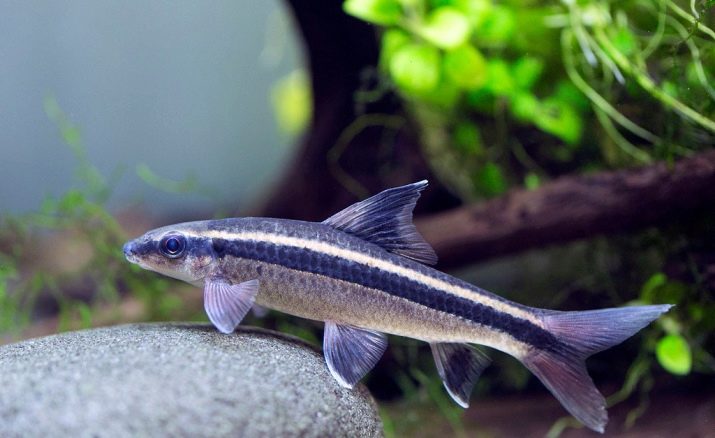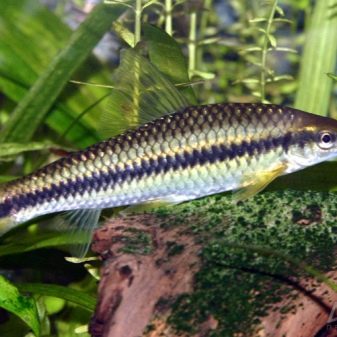Algae eater is an indispensable assistant to a real aquarist. The fish plays the role of a kind of stabilizer of the environment, ensures the maintenance of a healthy microbiological background in the tank. In nature, the species of aquarium fish that eat algae are found mainly in warm reservoirs of Southeast Asia with low-flowing water.
In artificial reservoirs - from small ponds to aquariums, where their mission becomes even more important, because in an enclosed space the uncontrolled reproduction of the smallest green microorganisms can lead to a significant deterioration in the properties of the environment in which the fish live.

Features and purpose
Algae eaters have been known in Russia since 1962, and already 8 years later they became completely indispensable among aquarists. Not the most striking in appearance, these quiet laborers play the role of a natural filter, make it possible to abandon the use of aggressive chemicals that inhibit the development of microscopic algae. The fish itself is unpretentious in content, gets along well with other species. But when choosing it, it is important to distinguish a real algae eater from its much less useful counterparts.
Under the name “algae eater”, fish species acting as peculiar cleaners of the aquarium environment are combined. These underwater inhabitants are fighting dangerous colonies of organisms that intensively produce chlorophyll and worsen living conditions in an enclosed space of an artificial reservoir. They eat algae, including dangerous parasites like the black beard. Some species feed exclusively on those living organisms found in the aquarium, while others can also absorb conventional feed.
The classic algae eater is a small fish with an elongated body, compact head, short fins. False species that feed mainly on aquarium mosses are distinguished. They are also quite useful, but have noticeable differences in the quality of cleaning the tank from algae pollution.

Among the features of algae eaters can be noted high level of activity. The streamlined body gives them good acceleration, allows them to swim upstream. Algae eaters rest, dropping to the bottom or landing on the leaves of plants. Siamese subspecies during sleep may turn upside down. During the rest period, the fins - abdominal and caudal - act as a support.
The life expectancy of algae eaters is up to 10 years. On one aquarium of medium size, it is enough to get no more than 2-3 individuals. The fishes are characterized by a livable character (a rare exception is the "flying fox").
To keep these cyprinids you need an aquarium with a lid - they are pretty jumping.

Kinds
All varieties of algae eaters can be divided into aquarium and wild. In addition, the most popular Siamese form has a false counterpart called the “flying fox”. It is not recommended to start it because of aggressive behavior (conflicts will inevitably arise in the aquarium) and its rather lazy extermination of excess flora.

Siamese
The most popular form is that it holds the majority of domestic aquarists. Tropical fish with a characteristic zigzag strip on the body and the caudal fin belongs to the family of cyprinids, prefers to stay close to the bottom of water bodies. Among the algae absorbed by it, one can distinguish red, filamentous, “flip flops”, “black beard”, in addition, it is believed that the Siamese subtype is the leader in terms of productivity.
Algae-eaters are quite large. In nature, they live in Southeast Asia and grow up to 14 cm in length. Aquarium Siamese algae eaters have half the body parameters.
They are characterized by the characteristic shape of the upper lip, not found in other fish of this family.

Antsistrus
Only the youngest individuals who have not grown to 4 cm are successfully struggling with green bloom. As the fish grows, its activity decreases. But in general, antiscistruses are often turned on to maintain optimal microflora in herbal aquariums.

Mollinsia
An omnivorous and absolutely unpretentious fish that has won the hearts of aquarists around the world. Molliesia or just molly destroys different types of dangerous vegetation. With its help, you can get rid of such algae as the "black beard", filamentous subspecies, remove plaque from the walls of the aquarium.
These fish are often bought on the occasion when an outbreak of microbial growth activity has already occurred. But in their effectiveness, they are much inferior to other subspecies of algae eaters.

Ototsinklus
Small, up to 3 cm in length, the fish eats algae with the help of a sucking mouth, mainly struggling with plaque on the walls of the aquarium. Otocincluses are effective against xenococci.
The choice of this species of algae eaters is most often due to its compact size and stealth in the aquarium. Such a fish easily copes with plaque on plants.

Girinoheylus or yellow algae eater
This fish with a sucker mouth is started mainly when a green coating appears on the walls of the aquarium. Especially often it occurs in tanks with intensive combination. Such fish are well suited for keeping in herbalists. But in the fight against filamentous algae, the "black beard" they are unsuitableIn addition, it must be taken into account that the girinoheylus feeds exclusively on green bloom, so you can not exceed the number of fish, otherwise the pets will starve.
Girinoheylus is often referred to as Chinese algae eater.

Who are compatible with?
The good compatibility of Siamese algae eaters with other fish makes it easy to populate them in any problematic aquariums, where there is an active reproduction of green organisms. It is optimal if 3 to 8 fish live in the tank.
In nature, they live in flocks, and this instinct is well developed. But when keeping males, fights will be inevitable. When selecting algae eaters, it is worth taking one male and several females.
Among the fish with which this species of beneficial aquarium inhabitants is incompatible are the following.
- Cichlids. They are annoyed by the excessive activity of small fish during the spawning period. They can show aggression, destroy young growth, which swam close to the laying of eggs.
- Two-tone labeos. This species is related to algae eaters and conflicts will inevitably arise between them. Fish can just die.
- Veil species of different fish species. Their tails and fins are algae eaters.


Growing conditions
For the content of algae eater in the aquarium, it is recommended to choose containers of at least 100 liters. Classic parallelepiped is suitable, which allows providing the necessary space for maneuvers and active movement of the fish. Water needs to be replaced with 1/3 of the volume weekly. Its optimal performance:
- temperature - from +24 to +26 degrees;
- acidity - 6.5-8 pH;
- hardness - 5-20 dGH.
When choosing a decor excesses should be avoided, leaving room for the movement of algae eater inside the aquarium. When choosing a substrate, it is worth giving preference to pebbles, dense sand. Fish absorbs the settled algae from the bottom, while the soil still has to be siphoned at least once a month, removing food residues absorbed by the inhabitants of the artificial reservoir.


The content of Siamese algae eater, as a typical representative of this species, requires the provision of soft non-directional lighting of natural or artificial origin. It is recommended to protect the aquarium from direct sunlight by screens or curtains. For algae eaters, a 12-hour daylight is important.
To create optimal growing conditions, it is worth taking care of the formation of a fast current. Reinforced water flow, intensive aeration should be carried out using special equipment. It is worth choosing the most powerful equipment, otherwise the pets will feel bad without sufficient oxygen saturation.
For relaxation, algae eaters need deciduous aquarium plants with large shoots. At the same time, the planted greens should not overshadow the pond or interfere with free movement.
Planted at the top of duckweed and richchia will not allow the active representative of the cyprinid family to leave the water tank without permission.

Feeding rules
In the natural environment, the Siamese algae eater feeds mainly on algae, but can also eat other green food, as well as protein food. The older the fish gets, the more its food preferences change, the need for additional protein increases. Adult algae eaters recommended additionally feed with artificial feed in granules and flakes, live and frozen insects.
Do not overfeed the fish - when saturated, they cease to fulfill their original tasks, become too lazy.

Feeding is carried out no more than 1 time per day. In food, you can enter any ready-made mixture for carps, as well as scalded fresh vegetables. Heat treatment is needed to eliminate potentially dangerous bacteria. Algae eaters willingly absorb spinach, cucumbers, lettuce, zucchini. Keeping food in water for more than 3 minutes is not recommended - residues are removed immediately upon completion of feeding.
As for live food, everything is not simple here either. Daphnia, cyclops, tubule, bloodworm are suitable as top dressing. Do not engage in self-fishing - an insect can be infected with dangerous bacteria. Frozen foods devoid of these deficiencies are considered safer. They are preliminarily kept at room temperature for about 15 minutes.
Do not get involved in planting moss in an aquarium with algae eaters. Having found it, the fish cease to absorb other food. Javanese mosses are especially loved by them. Do not plant them in containers with young animals.


For more information on the features of Siamese algae eaters, see the next video.










